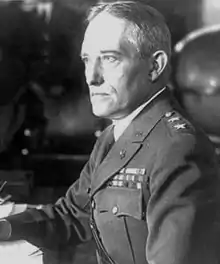George Sabin Gibbs
George Sabin Gibbs (December 14, 1875 – January 7, 1947) was a United States Army officer. After serving as a brigadier general during World War I, he was promoted to major general and served as Chief Signal Officer for the Signal Corps.
Chief Signal Officer, U.S. Army George Sabin Gibbs | |
|---|---|
 | |
| Born | December 14, 1875 Harlan, Iowa |
| Died | January 7, 1947 (aged 71) Coral Gables, Florida |
| Buried | |
| Allegiance | |
| Service/ | |
| Rank | |
| Service number | 0-746 |
| Commands held | U.S. Signal Corps |
| Battles/wars | Spanish–American War Philippine Insurrection World War I |
| Awards | Distinguished Service Medal Legion of Honour Order of St Michael and St George Order of the Crown (Belgium) Order of the Crown of Italy |
| Spouse(s) | Ruth Hobby[1] |
| Children | 5[1] |
Early life
Gibbs was born in Harlan, Iowa, in 1875. He graduated from Harlan High School in 1892, from the State University of Iowa in 1897, and by 1901 had earned a master's degree in engineering.[1]
Early military career
In 1898, Gibbs enlisted in the Iowa Volunteer Infantry as a private. During the Spanish–American War and Philippine Insurrection, Gibbs served in the volunteer forces, mainly on Signal Corps duty, in ranks from private to first lieutenant. While a sergeant, Gibbs was cited for gallantry in action against the Spanish forces at Manila.[1]
After being commissioned a first lieutenant in the Signal Corps, Regular Army, Gibbs' various duties included numerous surveys and construction of telegraph lines in Alaska[2] and as chief Army signal officer of the Cuban Pacification.[3]
Later military career
During World War I, Gibbs was the assistant Chief Signal Officer of the American Expeditionary Forces.[1][3] He was awarded the Distinguished Service Medal for his participation in the Aisne-Marne and Meuse-Argonne offenses. He also received several foreign awards,[1] including the Legion of Honour, Order of St Michael and St George, Order of the Crown of Belgium, and the Order of the Crown of Italy.[3]
His post World War I assignments included duty on the War Department General Staff and Executive Officer to the Assistant Secretary of War. In 1924, he supervised the completion of the new Washington–Alaska cable.[3]
Promoted to Major General, Gibbs became Chief Signal Officer on January 19, 1928.[4] He held this position until his retirement on June 30, 1931.[1]
Civilian career
After retirement, Gibbs was Vice President of the International Telephone and Telegraph Company[5] and in October 1931 President of the Postal Telegraph Cable Company.[6] Later, in 1934, he served as Vice Chairman of the board and a director of the Federal Telephone and Radio Corporation.[3]
Death and legacy
Gibbs died on January 7, 1947 at Coral Gables, Florida. He was buried with full military honors in Section 3 of Arlington National Cemetery.[1] His son David Parker Gibbs was a career army officer who attained the rank of major general and also served as head of the signal corps.[1]
Gibbs' papers are at the Library of Congress.[7]
References
- Davis, Jr., Henry Blaine (1998). Generals in Khaki. Pentland Press, Inc. pp. 142–143. ISBN 1571970886. OCLC 40298151.
- Gibbs, George S (February 1906). "Transportation Methods in Alaska". National Geographic. XVII (2).
- Marquis Who's Who 1975, p. 200.
- "Former "Buck Private" Wins His Star". Oelwin Daily Register. March 20, 1928.
- "Business: Personnel: Jul. 13, 1931". Time Magazine. July 13, 1931.
- "Business: Personnel: Oct. 26, 1931". Time Magazine. October 26, 1931.
- Kerwin, Patrick. "George Sabin Gibbs Papers" (PDF).
Bibliography
- "George Sabin Gibbs, Major General, United States Army." Arlington National Cemetery., which in turn was sourced from Coker, Kathy R., and Stokes, Carol E. A Concise History of The U.S. Army Signal Corps, p. 69, February 1991
- Marquis Who's Who (1975). Who Was Who In American History – The Military. Chicago, Illinois: Marquis Who's Who. ISBN 0837932017.
External links
| Wikimedia Commons has media related to George Sabin Gibbs. |
- "Signal Corps Regimental History". signal.army.mil. November 20, 2013. Retrieved September 21, 2015.
- George Sabin Gibbs at Find a Grave